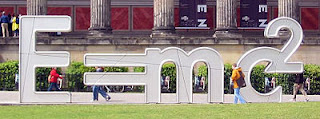In 1905, Albert Einstein showed that, as a consequence of his special theory of relativity, mass can be considered to be another form of energy. Thus the law of conservation of energy is really the law of conservation of mass-energy.
In normal everyday interactions, the amount of mass that is transferred into other forms of energy (or vice versa) is such a tiny fraction of the total mass that it is beyond our sensory perceptions and measurement techniques. Thus, in a chemical reaction, for example, mass and energy truly seem to be separately conserved. In a nuclear reaction, however, the energy released is often about a million times greater than in a chemical reaction, and the change in mass can easily be measured.
In physics, mass-energy equivalence is the concept that all mass has an energy equivalence, and all energy has a mass equivalence. Special relativity expresses this relationship using the mass-energy equivalence formula
E = mc²
where
E = the energy equivalent to the mass (in joules),
m = mass (in kilograms), and
c = the speed of light in a vacuum (celeritas) (in meters per second).
Origination of the formula is popularly attributed to Albert Einstein.
In the formula, c² is the conversion factor required to convert from units of mass to units of energy, i.e., the energy density. In unit-specific terms, E (joules or kg·m²/s²) = m (kilograms) multiplied by (299,792,458 m/s)2.
In normal everyday interactions, the amount of mass that is transferred into other forms of energy (or vice versa) is such a tiny fraction of the total mass that it is beyond our sensory perceptions and measurement techniques. Thus, in a chemical reaction, for example, mass and energy truly seem to be separately conserved. In a nuclear reaction, however, the energy released is often about a million times greater than in a chemical reaction, and the change in mass can easily be measured.
Mass-energy equivalence entails that the total mass of a system may change, although the total energy and momentum remain constant; for example, the collision of an electron and a proton annihilates the mass of both particles, but creates energy in the form of photons.
E = mc²
where
E = the energy equivalent to the mass (in joules),
m = mass (in kilograms), and
c = the speed of light in a vacuum (celeritas) (in meters per second).
Origination of the formula is popularly attributed to Albert Einstein.
In the formula, c² is the conversion factor required to convert from units of mass to units of energy, i.e., the energy density. In unit-specific terms, E (joules or kg·m²/s²) = m (kilograms) multiplied by (299,792,458 m/s)2.
The discovery of mass-energy equivalence was essential to the development of theories of atomic fission and fusion reactions.
Some Images of Mass–Energy Equivalence :
4-meter-tall sculpture of Einstein's 1905 E = mc2 formula at the 2006 Walk of Ideas, Berlin, Germany
Funny : (E=mc2)
Source:
en.wikipedia.org/wiki/Mass–energy_equivalence
www.thefreedictionary.com/mass-energy+equivalence










Mass-energy equivalence entails that the total mass of a system may change, although the total energy and momentum remain constant; for example, the collision of an electron and a positron (anti-electron) annihilates the mass of both particles and emits two gamma ray (photons).
ReplyDeleteE = MC Square now E2 + E1 / E2 -E1 = M1C1 Square + M2C2 Square / M2C2 Square - M1C1 Square
ReplyDeleteE2 + E1 = E2 - E1 ( M1C1 Square + M2C2 Square ) / M2C2 Square - M1C1 Square )
E2- E1 / M2C2 Square - M1C1 Square X numerator the same
E = E2 + E1 Finally
3E we get from the same in LHS now the rest goes 3 times the Previous.
Myself Joymalya CHAKRABORTY 8145460522
Delete